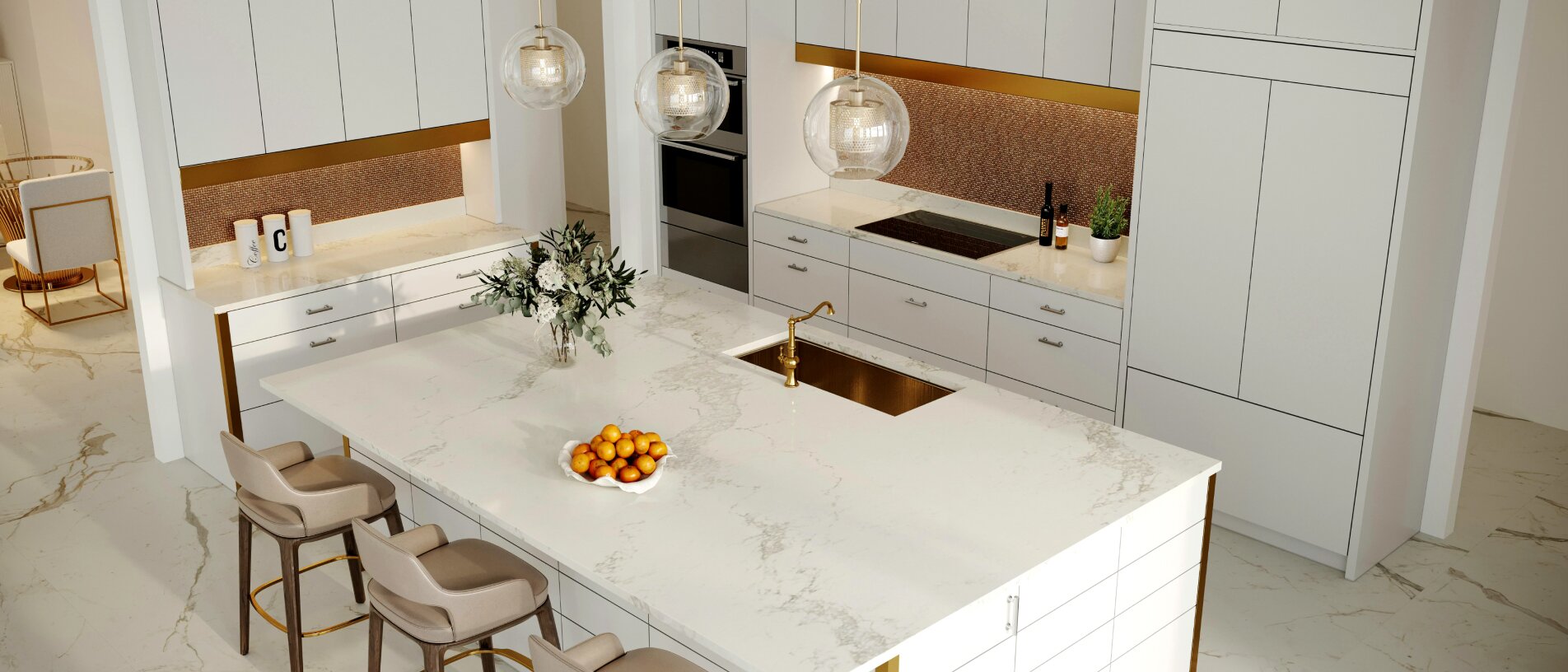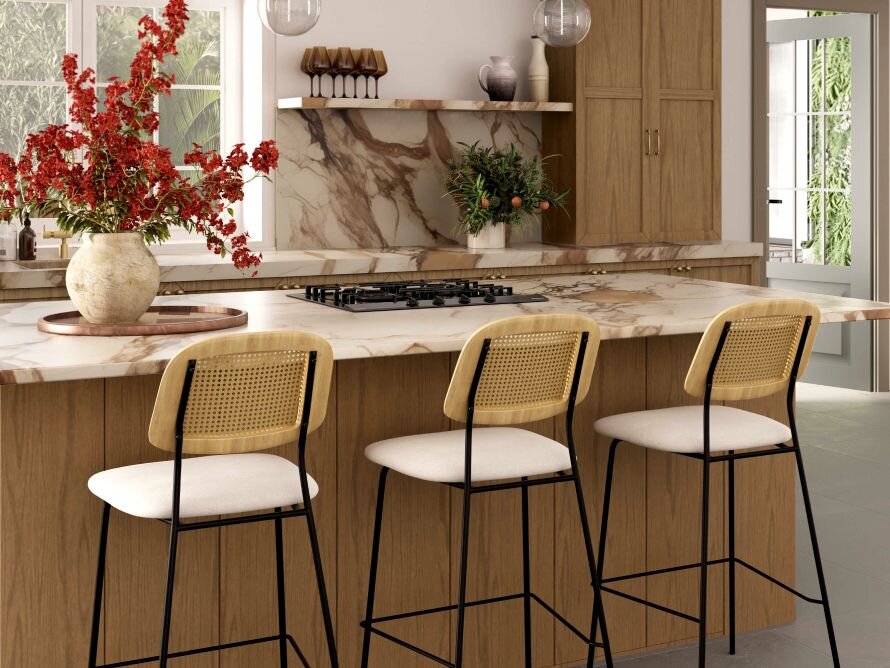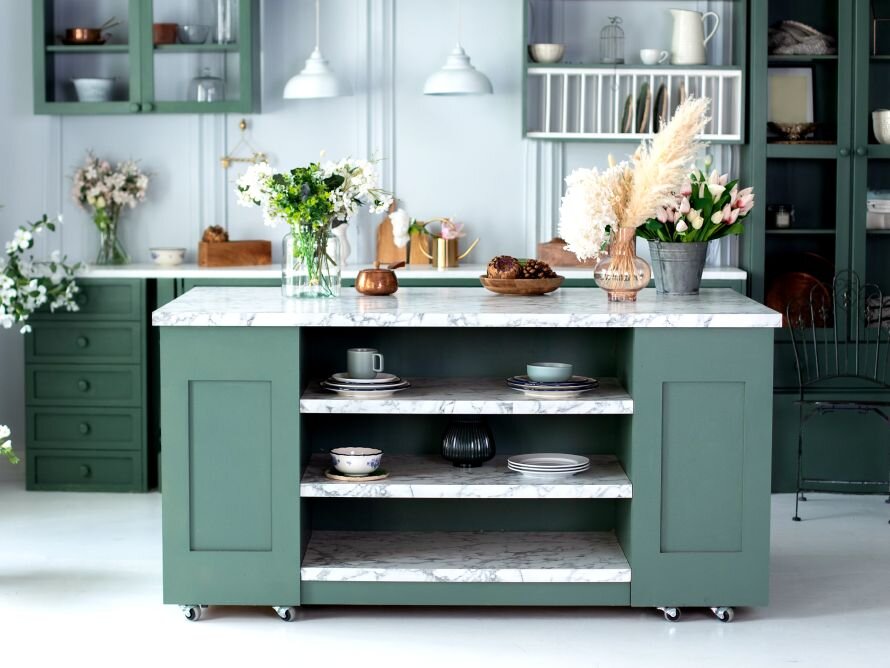You're on the list
By signing up, you agree to receive email marketing.


The kitchen is one of the most important rooms in your home. It’s where you create delicious food for yourself and your family. For many, it’s also where the family gathers to chat about work or school, tackle projects, or bond over a board game. But all that activity takes a lot of space. Adding an island to a kitchen is a great way to make the space you need for however you use your kitchen.
A kitchen island is a type of furniture that serves as an extra countertop in your kitchen. It’s called an island because it sort of “floats” in the middle of the room — it’s not attached to any of the other counters.
Some people use kitchen islands as an extra food prep surface, great for setting up your mise en place or kneading out dough. Some people also use their island as an additional eating spot, lining the counter with stools.
Islands can also be excellent for extra storage, with plenty of cabinet and drawer space for things such as utensils, pots and pans, or spare linens.
There are two main kinds of kitchen islands: portable and built-in. The main difference between these is their placement.
A portable kitchen island is one you can move around the space. It’s usually on wheels or casters, so you can easily roll it from place to place. This is a perfect option for smaller kitchens where a built-in kitchen island might be harder to place. A non-permanent kitchen island is also ideal for renters who may want extra counter space but can’t make major structural changes.
Portable kitchen islands are usually smaller than their built-in counterparts and don’t provide as much extra storage. Because they’re on wheels, you may run at risk of slipping while trying to knead or chop, so be careful.
If you’re looking for a more permanent addition to your kitchen, you might want a built-in kitchen island. These islands are stationary, usually affixed to the floor. Though they’re a little more challenging to install, there are many benefits to a permanent island.
Because they don’t need to move, built-in kitchen islands can incorporate infrastructure such as plumbing for an extra sink or water dispenser or electrical wiring to plug in appliances or spare chargers. Built-in islands can also be larger to accommodate more storage or seating. However, you can’t move them out of the way if you want to free up space.
There are a few things to consider when adding a kitchen island.
Kitchen islands are typically made of similar materials to other types of countertops. Though some people choose to match the material to their existing counters when adding a kitchen island, you don’t have to. Combining materials can add visual interest to your space or provide different surfaces for various kinds of food prep.
Marble countertops that are well cared for only get better with age. They often develop a darker patina that many find gives their kitchen a homey, vintage vibe. Marble comes in a variety of colors, allowing you to match it to any existing kitchen or dining room furniture. Be careful with certain kinds of food prep on a marble counter, however. Acidic foods such as vinegar or citrus juice can etch marble. Be sure to cut all your fruits and veggies on a proper cutting board. If you frequently clean kitchen surfaces with bleach, beware, as that can damage marble, too.
A butcher’s block island consists of sturdy strips of wood laid together in a pattern. Many people like butcher’s block because it’s easier to clean than other types of counters, making it ideal for everything from food prep to arts and crafts. However, unlike many other countertop materials, you can’t place hot pots or pans directly on its surface. This can cause scorching or burn marks in the wood, so ensure you have a potholder or a trivet handy.
Quartz is another popular kitchen island choice. In addition to being beautiful, it’s strong and durable. Unlike other stone countertops, it’s non-porous. This means it doesn’t require routine sealing and makes it easier to keep spick and span. Additionally, you can install quartz in one continuous segment, with no unsightly seams or crevices on longer counters or islands. Like marble, quartz comes in just about any color, matching any aesthetic. However, like butcher’s block, it’s susceptible to heat damage.
Stainless steel countertops are celebrated for their hygiene and durability. Their non-porous surface prevents bacteria and germs from hiding, making them easy to clean and maintain, and they don’t absorb liquids or odors, which further enhances their sanitary qualities. Additionally, these countertops are highly resistant to heat, allowing them to handle hot pots and pans without warping or discoloring. They also withstand stains and corrosion, so spills from various liquids won’t cause permanent damage. Known for their strength and longevity, stainless steel countertops endure heavy use and retain their appearance over time, making them a practical and stylish choice for both residential and commercial settings.


The size and shape of your kitchen island are pretty much up to personal preference. However, there are some basic guidelines to get you started before you add a kitchen island into your home. Generally, an island should take up about 10% of your kitchen’s total floor space.
You should aim for plenty of counter space to do what you need but have enough floor space to move around comfortably. Most designers recommend about 36-44 inches of walking space, depending on whether you plan to use your counter for extra seating.
When hanging out at the kitchen island, you need matching stools that fit in with the space and design of your kitchen. Bar stools are taller than traditional dining-sized chairs and come with additional features, such as a swiveling base, footrests, adjustable heights, to allow for easy movement and access.
Counter-height stools generally rise from 24"–26", which pairs well with counter-height tables or islands.
Bar height stools generally rise from 28”–32”, and pair with a bar-height table or island surface.
A general rule of seating is to allow 24 inches per person. This ensures that there is enough room to navigate in and out of the chairs.
Think about what kinds of things you’d like to store on your island. Do you need drawers for small items such as silverware? Would you like to store your extra pots and pans in a large cabinet underneath? Or are you planning for your island to double as a table, meaning you’ll need a little legroom underneath?
You could even incorporate an extra dish sink in a built-in island. This can be very convenient, but it does cut into the available storage space.
Think about how you’d like to use your island before you start shopping. Plan out what you’ll store there and how. It will help you find a kitchen island that meets all your needs.
An island is no good if you can’t see what you’re working on while using it. The right overhead lighting can add form and function to your kitchen design. Depending on your personal aesthetic, you may choose anything from an elegant chandelier to some minimalist recessed lighting.
Though it can be a little trickier to accommodate, movable kitchen island ideas for lighting might include a table lamp that you can plug in while using the island. Or you could move the island under your built-in lighting when needed, then roll it back out of the way when you finish.
Adding a kitchen island to your home offers many benefits aside from their aesthetic appeal. Not only do they provide you with extra counter space, but you also find styles that feature drawers, cabinets, or shelves. Some also have racks or hooks for keeping towels, utensils, or other kitchen accessories close at hand.
Outlets are generally required by code, and there should be at least one outlet for every 9 square feet of countertop. Incorporating outlets in your countertop spaces is ideal for charging devices and plugging in appliances.
Cabinets and cubbies on a kitchen island are a great usage of additional space to help with your storage needs. Store large countertop appliances, placemats, or other cooking essentials when they are out of use.
Drawers on your kitchen island are great for keeping the clutter off the countertops. Store your laptops, cookbooks, or small cooking utensils so they are out of the way when not in use.
Kitchen islands can be a great addition to the functionality and flow of your kitchen. Many varieties come with a sink or cooktop so that your kitchen usability is enhanced.
Adding a kitchen island is an excellent way to add more storage and counter space. Islands come in many shapes, sizes, and styles, so there’s one to accommodate any kitchen type and every family’s aesthetic.
Explore More
You're on the list
By signing up, you agree to receive email marketing.